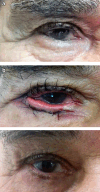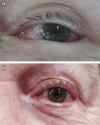Randomized Controlled Trial Comparing Everting Sutures with a Lateral Tarsal Strip for Involutional Lower Eyelid Entropion
- PMID: 31127533
- PMCID: PMC6692799
- DOI: 10.1007/s40123-019-0189-3
Randomized Controlled Trial Comparing Everting Sutures with a Lateral Tarsal Strip for Involutional Lower Eyelid Entropion
Abstract
Introduction: To compare the anatomical and functional outcome and changes in the quality of life (QoL) over time of the lateral tarsal strip (LTS) versus the Quickert everting sutures (ES) for the repair of primary involutional lower eyelid entropion.
Methods: Forty-five patients (54 eyes) with primary involutional lower eyelid entropion were recruited in a prospective randomized clinical trial over 3-year period. Twenty-six eyes were randomized to the LTS technique and 28 to the ES procedure. Primary outcome was the anatomical correction of the eyelid at the final assessment in 1 year. Secondary outcomes were function and symptoms assessment with a QoL questionnaire at 6 months. Fisher's exact test was used for the statistical analysis of success rate and gender study and Mann-Whitney U test and logistic regression analysis were used for age study. The Wilcoxon and Mann-Whitney U tests were used for the analysis of the National Eye Institute Visual Functioning Questionnaire-25 (NEI VFQ-25).
Results: At the 6-month follow-up, 25 eyes (96.2%) of the LTS group and 20 (71.4%) of the ES group had favorable outcome (P = 0.025). There were one and eight eyes, respectively, with early recurrence. At the final 12-month evaluation, 23 eyes (88.5%) in the LTS group and 16 eyes (57.1%) in the ES group were successful. Three (11.5%) and 12 (42.9%) eyes respectively showed postoperative recurrence. There was a statistically significant difference between the two groups (P = 0.015) for the primary outcome, whereas age and gender did not influence success. The NEI VFQ-25 showed statistically significant subjective improvement from baseline in most categories of the QoL. No significant difference between the two procedures was detected at 6 months.
Conclusion: This study suggests that the LTS procedure has a superior surgical success rate and reduction of symptoms compared with the ES for the repair of involutional lower eyelid entropion. Both procedures showed similar improvement of the postoperative QoL.
Trial registration: International Clinical Trials Registry Platform identifier: ACTRN12616000620426.
Keywords: Everting sutures; Eyelid; Involutional entropion; Lateral tarsal strip; Quickert; RCT.
Conflict of interest statement
Elias A. Nakos, Konstadinos G. Boboridis, Angeliki A. Kakavouti–Doudou, Diamantis D. Almaliotis, Christos E. Sioulis and Vasileios E. Karampatakis have nothing to disclose.
Figures
Similar articles
-
A comparison of the lateral tarsal strip with everting sutures and the Quickert procedure for involutional entropion.Acta Ophthalmol. 2019 Sep;97(6):e933-e936. doi: 10.1111/aos.14093. Epub 2019 Mar 27. Acta Ophthalmol. 2019. PMID: 30916886
-
Comparison of Surgical Outcome Between Quickert Suture and Quickert Suture With Modified Lateral Tarsal Strip in Involutional Lower Eyelid Entropion.J Craniofac Surg. 2016 Jan;27(1):198-200. doi: 10.1097/SCS.0000000000002287. J Craniofac Surg. 2016. PMID: 26703055
-
A randomized controlled trial comparing everting sutures with everting sutures and a lateral tarsal strip for involutional entropion.Ophthalmology. 2010 Feb;117(2):352-5. doi: 10.1016/j.ophtha.2009.06.056. Epub 2009 Oct 28. Ophthalmology. 2010. PMID: 19875173 Clinical Trial.
-
Eyelid entropion.Semin Ophthalmol. 2010 May;25(3):52-8. doi: 10.3109/08820538.2010.488573. Semin Ophthalmol. 2010. PMID: 20590413 Review.
-
Involutional entropion: risk factors and surgical remedies.Curr Opin Ophthalmol. 2015 Jul;26(5):416-21. doi: 10.1097/ICU.0000000000000186. Curr Opin Ophthalmol. 2015. PMID: 26154839 Review.
Cited by
-
Pretarsal orbicularis oculi muscle tightening with skin flap excision in the treatment of lower eyelid involutional entropion.BMC Ophthalmol. 2021 Dec 15;21(1):435. doi: 10.1186/s12886-021-02214-9. BMC Ophthalmol. 2021. PMID: 34911482 Free PMC article.
-
Comparison of the cutaneous orbicularis oculi excision treatment with the inferior eyelid margin fixation treatment for congenital lower eyelid entropion.Int Ophthalmol. 2023 Jul;43(7):2153-2159. doi: 10.1007/s10792-022-02610-0. Epub 2023 Jan 5. Int Ophthalmol. 2023. PMID: 36604394
-
Response to Comments on Randomized Controlled Trial Comparing Everting Sutures with a Lateral Tarsal Strip for Involutional Lower Eyelid Entropion.Ophthalmol Ther. 2020 Jun;9(2):369-370. doi: 10.1007/s40123-020-00240-2. Epub 2020 Feb 25. Ophthalmol Ther. 2020. PMID: 32100201 Free PMC article. No abstract available.
-
Outcomes of combined procedures compared to various single techniques for involutional entropion.Oman J Ophthalmol. 2023 Oct 18;16(3):439-445. doi: 10.4103/ojo.ojo_43_23. eCollection 2023 Sep-Dec. Oman J Ophthalmol. 2023. PMID: 38059104 Free PMC article.
-
Towards optimal management of lower eyelid malpositions: A systematic review of treatment effectiveness and safety.Clinics (Sao Paulo). 2024 Dec 3;80:100547. doi: 10.1016/j.clinsp.2024.100547. eCollection 2025. Clinics (Sao Paulo). 2024. PMID: 39631150 Free PMC article.
References
-
- Levine MR, Enlow MK, Terman S. Spastic entropion after cataract surgery. Ann Ophthalmol. 1992;24:195–198. - PubMed
LinkOut - more resources
Full Text Sources



